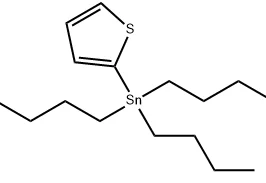- This topic is empty.
-
AuthorPosts
-
2025-10-23 at 4:17 pm #10208
2-(Tributylstannyl)thiophene (Cas No.: 54663-78-4) is a clear, almost colorless organotin compound with the molecular formula C₁₆H₃₀SSn and a molecular weight of 373.18 g/mol. This compound is widely utilized as a stannylated intermediate in organic synthesis, particularly in Stille coupling reactions, due to its high reactivity and selectivity in carbon–carbon bond formation.
Physically, 2-(Tributylstannyl)thiophene exhibits a boiling point of 155 °C at 0.1 mmHg, a density of 1.175 g/mL (25 °C), and a refractive index of 1.518. Its flash point of 221 °F reflects moderate volatility and a need for careful temperature control during handling. It is typically stored under inert gas—nitrogen or argon at 2–8 °C—to maintain chemical stability and prevent oxidation.
Physicochemical Characteristics and Safety Profile of Tributylstannylthiophene
1. Physicochemical Properties
2-(Tributylstannyl)thiophene demonstrates excellent thermal stability, making it suitable for vacuum distillation purification at low pressures. It also possesses high solubility in polar solvents such as tetrahydrofuran (THF) and diethyl ether, which facilitates its use in low-temperature reaction systems and organometallic synthesis.
Its refractive index (n20/D 1.518) serves as a reliable parameter for verifying compound purity during synthesis and quality control. These features collectively enable high reproducibility and reliability in experimental conditions.
2. Safety and Environmental Considerations
This compound is classified as highly toxic (T), with potential for acute poisoning through ingestion, inhalation, or dermal exposure (classified under H301, H312). Moreover, it poses serious environmental risks—notably chronic aquatic toxicity (H410) and long-term bioaccumulation potential (H372).
When working with 2-(Tributylstannyl)thiophene, strict protective measures (P280)—including chemical-resistant gloves, protective goggles, and respirators—must be followed. In the event of a spill, adsorption with diatomaceous earth and hazardous waste disposal (S60/S61) are required. For logistics, the compound is transported under UN 2788, Packing Category III, with appropriate toxicity labeling.

Efficient Synthesis Methods for 2-(Tributylstannyl)thiophene
1. Lithium–Halogen Exchange Route (High Efficiency, ~90% Yield)
This is the most widely adopted method for synthesizing 2-(Tributylstannyl)thiophene due to its high yield and purity. The process involves the following steps:
* Step 1: Dissolve 2-bromothiophene in anhydrous THF.
* Step 2: Add n-butyllithium dropwise at −20 °C to generate 2-thienyllithium.
* Step 3: Introduce tributyltin chloride (Bu₃SnCl) slowly, maintain at −20 °C for 1 hour, and allow to react overnight at room temperature.
* Step 4: Quench with water, extract with dichloromethane, wash with brine, and dry over anhydrous MgSO₄.
* Step 5: Purify using column chromatography (petroleum ether/triethylamine) to yield a clear, colorless liquid.
This route benefits from excellent selectivity and minimal by-product formation, making it ideal for laboratory-scale and pilot-scale synthesis.
2. Magnesium Activation Method (Moderate Yield, 55–78%)
An alternative involves activating magnesium with 1,2-dibromoethane as an initiator. In this method:
* Magnesium chips, 2-bromothiophene, and Bu₃SnCl are reacted in THF at 35 °C under sonication.
* Reaction progress is monitored via TLC, then quenched with saturated ammonium chloride solution.
* The organic layer is extracted with ethyl acetate and purified through column chromatography on KF-doped silica gel with hexane/ether elution.
This method, though less efficient, offers a simpler setup for large-scale industrial applications.
Optimizing the Synthesis Process for Industrial Production
Achieving consistent quality and high yield of 2-(Tributylstannyl)thiophene relies on rigorous process control:
* Anhydrous Environment: Maintaining argon protection is essential, as lithium reagents react violently with moisture or oxygen.
* Temperature Regulation: Low temperatures (−20 °C) minimize side reactions and ensure precise regioselectivity.
* Purification Strategy: Incorporating triethylamine in chromatography prevents decomposition of tin reagents and enhances yield stability.
These optimizations make the compound suitable for semiconductor-grade materials and pharmaceutical synthesis, where impurity levels must be tightly controlled.
Core Application Scenarios of 2-(Tributylstannyl)thiophene
1. Organic Optoelectronic Material Synthesis
2-(Tributylstannyl)thiophene is a key intermediate in Stille coupling reactions, enabling C–C bond formation with halogenated aromatics under palladium catalysis. This reaction pathway is central to producing conjugated polymers used in organic photovoltaics (OPVs) and organic light-emitting diodes (OLEDs).
Notably, thiophene-based copolymers such as poly(thiophene-benzene) exhibit excellent charge transport and photoluminescent properties, making this compound indispensable in next-generation flexible electronics.
2. Pharmaceutical Intermediate
Thiophene rings are critical structural motifs in many pharmaceuticals. 2-(Tributylstannyl)thiophene acts as a synthetic precursor in the preparation of antimicrobial, anti-inflammatory, and neuroactive agents, where the stannylation step enables site-selective functionalization of heteroaromatic systems.
3. Polymer Material Modification
In polymer chemistry, 2-(Tributylstannyl)thiophene can function as a crosslinking agent or plasticizer in formulations such as polyvinyl chloride (PVC). It enhances the mechanical flexibility, thermal resistance, and processability of the polymer matrix, extending the lifespan of industrial plastic products.
Conclusion:
2-(Tributylstannyl)thiophene serves as a vital intermediate bridging organotin chemistry and advanced material science. Its robust synthetic routes, predictable reactivity, and broad applicability in electronics, pharmaceuticals, and polymer modification make it a cornerstone compound in modern synthetic chemistry.
-
AuthorPosts
- You must be logged in to reply to this topic.
